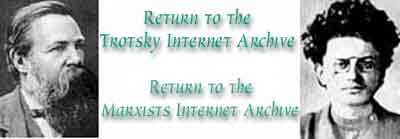
Written: 29 November 1937.
Published: Socialist Appeal, Vol. I No. 18, 11 December 1937, p. 3.
Transcription/Mark-up: Einde O’Callaghan.
Copyleft: Leon Trotsky Internet Archive (www.marxists.org) 2015. Permission is granted to copy and/or distribute this document under the terms of the Creative Commons Attribution-ShareAlike 2.0.
The unification of the world trade union organization, in the present case the adherence of the Soviet Union to the Amsterdam International, could bring great advantages to the working class – under only one condition: that there are actually unions in the U.S.S.R. But there are none there. There is a trade union apparatus totally dependent upon the ruling clique and dominating the working masses. Thus, during the last bloody purge, which is, moreover, far from being ended, the central Council of Trade Unions was totally reorganized without the so-called unionized masses knowing more than what appeared in the official press. The purge of the trade union apparatus was done by the G.P.U. upon the direct order of Stalin.
The former trade union leader, the old revolutionary, Tomsky, was driven into suicide by a campaign of calumnies and vicious persecution. His place was taken, without the least consultation with the membership, by Shvernik, who was never and is nothing more than a bell-hop in the personal service of Stalin. The renovated apparatus occupies itself in its turn with purging the factories and the offices, in hunting and trapping whoever is discontented, critical, or makes demands. Thus the so-called unions represent an organization of industrial police, an appendage of the G.P.U. and not at all an autonomous organization of workers.
It is not a question then of the unification of the working masses, but of a diplomatic accord between the Amsterdam apparatus, decently conservative, and the police apparatus of Moscow.
The heads of the British trade unions would like well enough to orient the external policy of their country toward a rapprochement with France, the United States, and the U.S.S.R. The French policy, that of the People’s Front, is based upon the support of Moscow. Jouhaux, the head of the French union, while proclaiming the “independence” of his trade unions, belongs in reality to the People’s Front. It is this political conjuncture, nationally and internationally, which has determined the rapprochement of the Amsterdam trade union bureaucracy with the pseudo-trade union bureaucracy of Moscow.
We must add still another element which is not without importance. Already for some years, practically since 1924, Stalin has purchased precisely through the intermediary of the so-called trade union apparatus the “sympathies” of various trade union leaders abroad, commencing with England. We are able to cite some cases of British trade union heads on the regular Moscow payroll. Others have benefited through exceptional privileges, or their wives have received presents in gold or in platinum. This practice of demoralizing the workers’ leaders was, be it said in passing, one of the principal points of my struggle against Stalin’s clique.
When I become aware of this practice, in the spring of 1925, I protested vigorously. “But why?” Stalin countered, “Do not the bourgeoisie buy the workers’ leaders?” “One can buy,” I answered, “somebody in order to corrupt him, but not in order to make him a fighter for the emancipation of the oppressed.” This practice has since that time taken on gigantic proportions. We must not forget that the gold industry has made great progress in the U.S.S.R. The industry of bribery and of corruption has made still greater progress.
Many of the so-called “friends” of the U.S.S.R. who have nothing in common with the Russian people, its revolutionary traditions, its sufferings, and its aspirations are not more than interested friends of the ruling clique of the Kremlin. Some of them are paid directly with gold. Others depend in their personal political aims upon the aid of the powerful international apparatus of Moscow.
I do not doubt that Stalin, Yezhov, and Shvernik will utilize the so-called trade union unification in order to enlarge their hold upon the number of leaders with a supple spine and conscience. What will be the reaction of the working class against these practices? We shall see in the coming years.
Coyoacan, D.F., Nov. 29, 1937

Last updated on: 31 July 2015